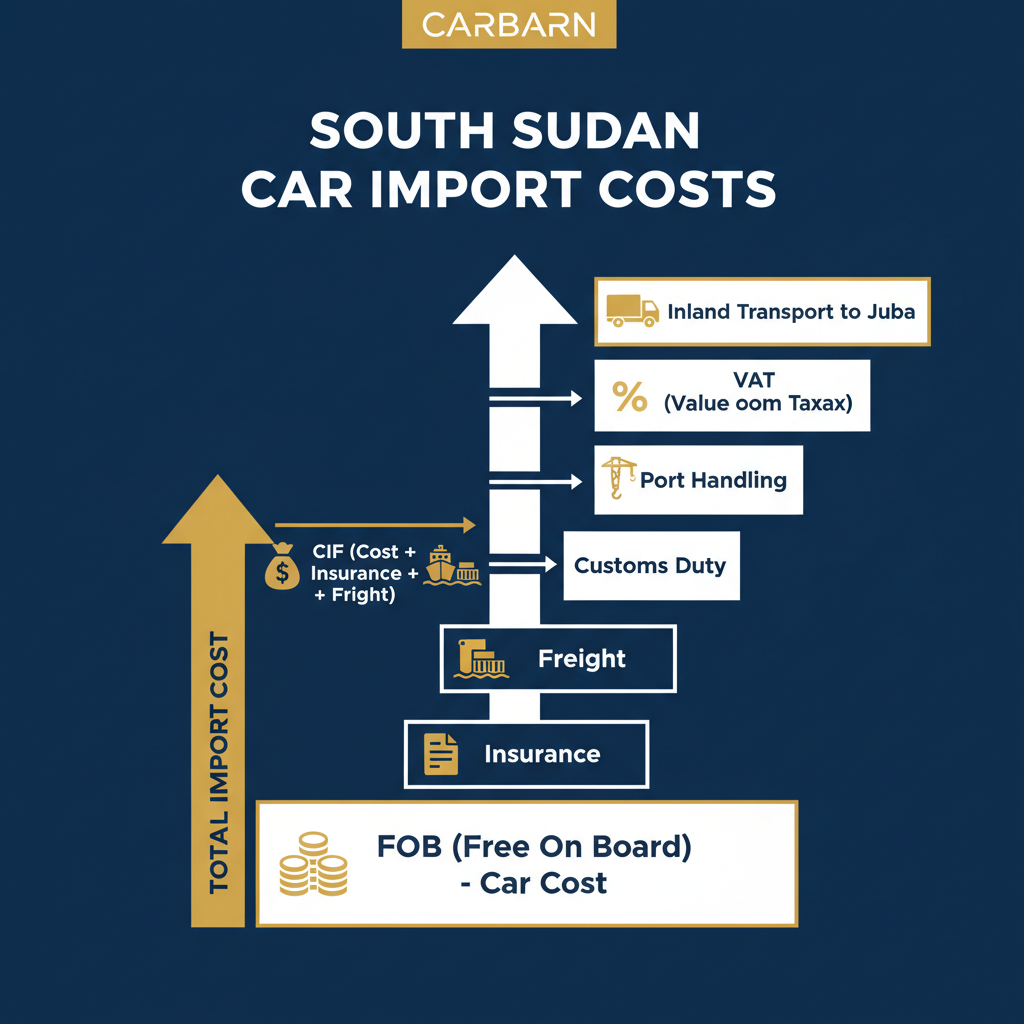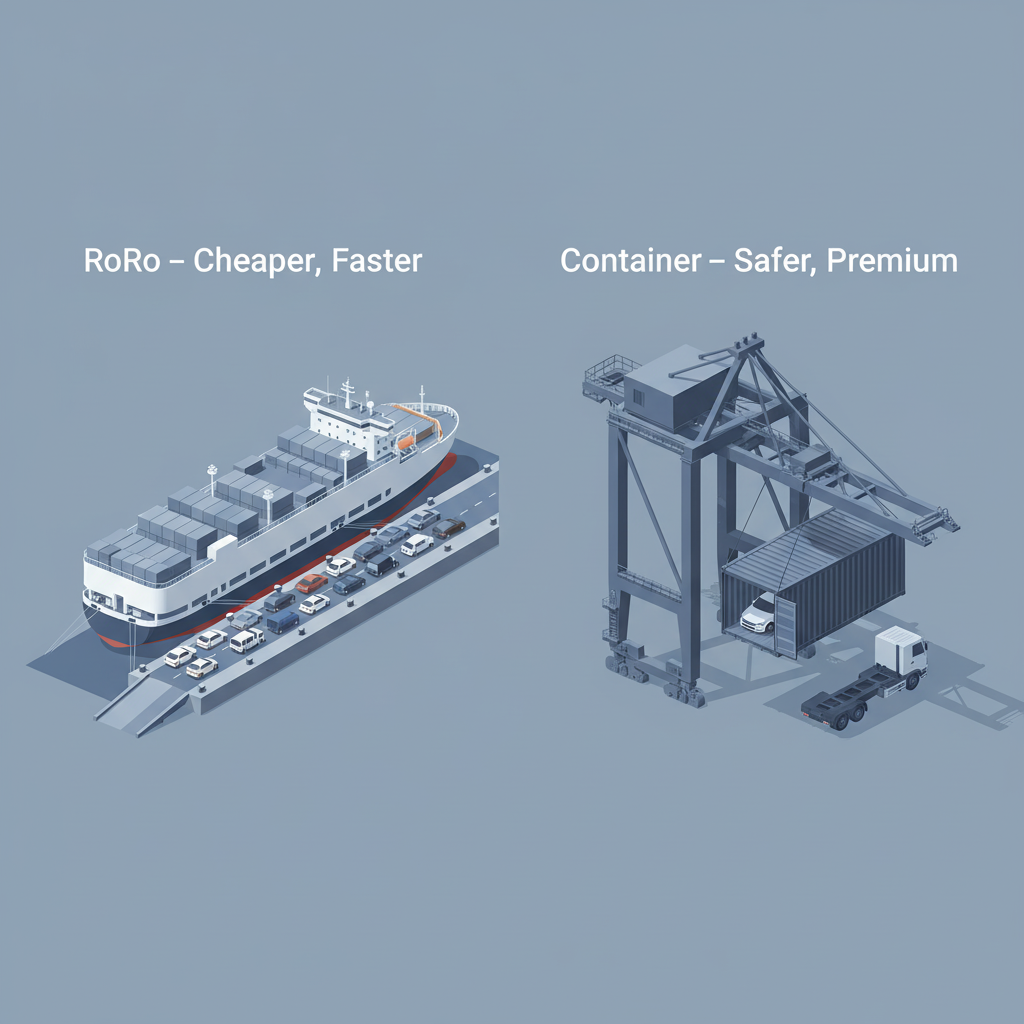South Sudan Car Import 2025: Costs, Ports & Rules
Read Our Blogs today and Learn More

Importing a car into South Sudan doesn’t have to feel complicated. With clear car import rules, predictable routes through Mombasa and Port Sudan, and the right understanding of CIF (Cost, Insurance, Freight), you can bring reliable Japanese used cars to South Sudan smoothly and cost-effectively.
In this comprehensive 2025 guide, you’ll learn how South Sudan car import duties work, what paperwork is needed, how long it takes for cars to arrive, and what kind of vehicles make the most sense for the country’s diverse roads. You’ll also get insights into EV and hybrid car imports, learn the risks to avoid, and understand the total cost structure, from ocean shipping to registration. Whether you’re a first-time buyer or managing bulk imports, this guide will help you make confident, informed decisions every step of the way.
Why Imports Dominate the South Sudan Market
The majority of vehicles on South Sudan’s roads are used imports, and for good reason. Buying locally is limited, and importing directly from Japan, the UAE, or the UK provides better pricing and quality options. Over 80% of cars on the market are pre-owned Japanese vehicles—valued for reliability, spare part availability, and fuel efficiency. Local buyers typically search for car prices in South Sudan, the best SUVs for South Sudan roads, and car import rules before committing to a purchase. The focus is always on vehicles that handle both city conditions in Juba and rough, unpaved roads outside the capital.

South Sudan Car Import Rules
Unlike many African countries, South Sudan does not enforce strict age limits for imported cars. This flexibility makes it easier to find a balance between price and condition. Both left-hand drive (LHD) and right-hand drive (RHD) vehicles are allowed, which opens up sourcing options from Japan, the UAE, and even Europe. Essential documents include the vehicle’s title, Bill of Lading, commercial invoice, and import declaration. Duties and VAT are calculated based on the CIF value, which represents the car’s total landed cost. Electric vehicles and hybrids may also need a Certificate of Conformity for compliance. Although pre-shipment inspections are not mandatory, obtaining one is strongly recommended. It protects buyers from hidden issues like accident damage or flood exposure.
Understanding Costs and CIF Duties
In South Sudan, import taxes are based on the CIF value, which is the sum of the car’s cost, marine insurance, and freight to the port of entry. Once calculated, duties, VAT, and clearance fees are added on top. For example, if a car costs $4,000 in Japan, with $200 insurance and $1,000 freight, your CIF value would be $5,200. Customs duties are applied on that amount, not just the base vehicle price. After duty and VAT, you’ll also pay for handling, documentation, and inland transportation from the port to South Sudan. When comparing quotes, always check whether the price is FOB (car only) or CIF (all-inclusive). The difference can drastically change your final cost.
Ports and Transport Corridors
The main shipping gateways for used cars to South Sudan are Mombasa Port (Kenya) and Port Sudan. Mombasa is the most common route, with cars transported inland through Nimule or Nadapal. Port Sudan is used less frequently but can be faster or cheaper depending on freight availability and cargo class. Shipping times average 24 to 36 days, depending on vessel schedules, customs queues, and road conditions. After the car arrives at port, inland transport to Juba can take several additional days. The improved Juba–Terekeka–Rumbek road network has reduced delivery delays and boosted the movement of 4x4 vehicles and trucks deeper into the country.
RoRo vs. Container Shipping
There are two main shipping methods for South Sudan car imports: RoRo (Roll-on/Roll-off) and Container Shipping. RoRo is more affordable. Vehicles are driven directly onto the ship, secured during transit, and rolled off at the destination. It’s ideal for standard cars and SUVs. The downside is limited protection from sea salt or theft, although these risks are rare. Container shipping, while more expensive, offers additional security, your car is sealed inside a steel container. This method is best for high-value vehicles or when you’re shipping multiple cars together. It’s also preferred for delicate cars like sports models or EVs that require extra handling care.

Choosing the Right Car for South Sudan Roads
South Sudan’s mixed road network demands versatile, durable vehicles. In the capital Juba, sedans and compact hatchbacks like the Toyota Corolla, Mazda Demio, and Nissan Note dominate for their fuel efficiency and maneuverability. For rural areas and up-country use, SUVs and 4x4s such as the Toyota Land Cruiser, Hilux, Subaru Forester, and Mazda CX-5 perform best. These models can withstand rough terrain, mud, and long-distance driving. Families and businesses often opt for multipurpose vans like the Toyota Hiace and Nissan Serena, offering large capacity and comfort. For young professionals, the Suzuki Swift remains a popular choice for affordability and easy maintenance.
These models hold their value well, and spare parts are widely available in Juba, making them the most practical options for long-term ownership.
Step-by-Step Import Process
Choose your car – Select a verified model from a reputable exporter or marketplace in Japan, the UAE, or the UK.
Confirm details – Request an inspection report, auction sheet, and chassis number verification.
Negotiate and pay – Finalize the deal and pay for the car, insurance, and shipping (CIF).
Ship your car – Book your space via RoRo or container. Track shipment progress to Mombasa or Port Sudan.
Clear customs – Provide all documents and pay duties and taxes based on CIF.
Transport inland – Move the car via Nimule or Nadapal to Juba or other regions.
Register your vehicle – Complete registration, get license plates, and arrange for insurance.
This process typically takes 4 to 8 weeks from purchase to delivery, depending on scheduling and customs efficiency.
EVs and Hybrids: The 2025 Reality Check
While electric vehicles are slowly gaining attention, South Sudan’s infrastructure is still developing. With limited public charging points and inconsistent electricity, hybrids are currently the smarter option.
Models like the Toyota Prius or Honda Vezel Hybrid offer excellent fuel savings without needing full electric support. As government policy evolves and charging networks expand, full EVs like the Nissan Leaf will become more practical. For now, hybrids deliver the ideal mix of efficiency and reliability for South Sudan’s conditions.
Common Pitfalls to Avoid
Undisclosed damage – Always verify vehicle condition using auction sheets or third-party inspection.
Fake paperwork – Double-check VIN numbers and ensure the Bill of Lading and title match.
Hidden shipping costs – Confirm all CIF components before paying.
Delayed delivery – Avoid bookings during peak shipping months when rollovers are common.
Inexperienced brokers – Work with import agents familiar with South Sudan’s border procedures at Nimule or Nadapal.
Being proactive about verification can save thousands in unexpected costs and delays.
Maintenance, Insurance, and Resale
After your car arrives, regular maintenance is key to keeping it roadworthy. Juba has a growing number of workshops specializing in Toyota, Nissan, and Mazda, with easy access to spare parts imported from Kenya and Uganda. For insurance, opt for comprehensive coverage that protects against theft, accidents, and natural damage. Vehicles like Toyota and Nissan models retain their resale value best, especially SUVs and vans, due to strong local demand.
Quick Takeaways
No age limit: South Sudan allows both new and used vehicles of any year.
LHD and RHD cars: Both are legal to import.
Main routes: Mombasa via Nimule or Port Sudan.
Duties based on CIF: Always calculate taxes on total landed cost.
Best buys: Toyota Hilux, Land Cruiser, Corolla, Mazda CX-5, Subaru Forester, Honda Vezel.
Hybrids are practical, EVs early stage: Good for future planning, but not yet mainstream.
Importing a car into South Sudan in 2025 is straightforward once you understand the rules. With flexible import policies, open drive-side regulations, and simple documentation, South Sudan remains one of East Africa’s most accessible markets for used vehicles. Focus on cars that match your lifestyle and local roads: rugged SUVs for rural travel, efficient sedans for city driving, or hybrid models if you prioritize fuel savings. Always compare CIF quotes carefully, double-check paperwork, and partner with experienced importers who can handle customs smoothly.
With the right preparation, you can land a reliable Japanese used car in South Sudan faster and more affordably than ever before.
Why Choose Carbarn South Sudan?
When it comes to buying Japanese used cars in South Sudan, Carbarn stands out for its honesty, quality, and experience. Every vehicle we list is carefully inspected, verified for mileage and condition, and comes with transparent pricing that includes full CIF cost details. Whether you’re in Juba, Wau, or Yei, Carbarn South Sudan makes car ownership simple — from selection and shipping to customs clearance and delivery. We partner with trusted exporters in Japan and ensure all imports meet South Sudan’s legal and mechanical standards. With a dedicated support team, nationwide delivery options, and after-sales guidance, Carbarn isn’t just selling cars; we’re delivering peace of mind, reliability, and long-term value to every customer on the road.
Frequently Asked Questions (FAQs)
Arif Hasnat
Car Specialist | Writer
Published Date
October 28, 2025